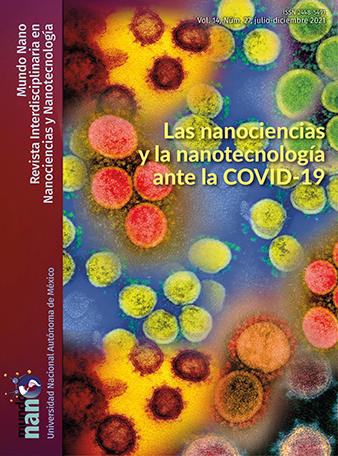El potencial de las nanopartículas de Ag y Cu para la fabricación de recubrimientos fotocatalíticos para mitigar la propagación de la COVID-19
Resumen
En el trabajo se aborda el uso de diferentes tipos de nanopartículas (NP’) con propiedades fotocatalíticas y antimicrobianas, con posible uso para mitigar la propagación del virus SARS-CoV-2 que provoca la enfermedad COVID-19. El trabajo está estructurado con énfasis en el mecanismo por el cual las NPs de Ag y Cu pueden eliminar virus y bacterias. Posteriormente, se aborda la preparación de materiales, como las zeolitas, que contienen impregnadas a las NPs de Ag y Cu. Otras de las NPs presentadas son las de ZnO y TiO2, las cuales también presentan altas eficiencias para eliminar microorganismos. Por último, se analizan algunos trabajos en donde las NPs, en suspensión o soportadas, se emplearon para preparar pinturas. Estas pinturas se evaluaron para degradar algunos contaminantes atmosféricos; no obstante, lo más interesante fue su uso como recubrimientos antibacterianos. Si bien, la mayoría de los trabajos se enfocaron en comprobar las propiedades antimicrobianas de las pinturas, su uso se puede extender hacia la inactivación de virus, como el SARS-CoV-2. Esto permitiría utilizar estos recubrimientos en zonas con alta frecuencia del virus, como es el caso de hospitales o áreas de alto contacto humano.
Citas
Allaker, R. P., Memarzadeh K. (2014). Nanoparticles and the control of oral infections. International Journal of Antimicrobial Agents, 43: 95-104. https://doi.org/10.1016/j.ijantimicag.2013.11.002
Alswat, A. A., Bin Ahmad M., Hussein M. Z., Ibrahim N. A., Saleh T. A. (2017). Copper oxide nanoparticles-loaded zeolite and its characteristics and antibacterial activities. Journal of Materials Science and Technology, 33: 880-896. https://doi.org/10.1016/j.jmst.2017.03.015
Anpo, M., Shima T., Kodama S., Kubokawa Y. (1987). Photocatalytic hydrogenation of propyne with water on small-particle titania: size quantization effects and reaction intermediates. The Journal of Physical Chemistry, 91(16): 4305-4310. https://doi.org/10.1021/j100300a021
Auchynnikava, A. A., Vorobyova A., Rzheussky S. E. (2015). Antimicrobial activity of copper nanoparticles depending on the particles size. En Physics, chemistry and application of nanostructures, 480-483. https://doi.org/10.1142/9789814696524_0118
Azizi-Lalabadi, M., Ehsani A., Divband B., Alizadeh-Sani M. (2019). Antimicrobial activity of titanium dioxide and zinc oxide nanoparticles supported in 4A zeolite and evaluation the morphological characteristic. Scientific Reports, 9: 17439. https://doi.org/10.1038/s41598-019-54025-0
Bleichert, P., Espírito Santo Ch., Hanczaruk M., Meyer H., Grass G. (2014). Inactivation of bacterial and viral biothreat agents on metallic copper surfaces. Biometals, 27: 1179-1189. https://doi.org/10.1007/s10534-014-9781-0
Bright, K. R., Sicairos-Ruelas E. E., Gundy P. M., Gerba Ch. P. (2009). Assessment of the antiviral properties of zeolites containing metals ions. Food Environmental Virology, 1: 37-41. https://doi.org/10.1007/s12560-008-9006-1
Chatterjee, A. K., Chakraborty R., Basu T. (2014). Mechanism of antibacterial activity of copper nanoparticles. Nanotechnology, 25: 135101. https://doi.org/10.1088/0957-4484/25/13/135101
Chuang, K-T., Abdullah H., Leu S-J., Cheng K-B., Kuo D-H., Chen H-Ch., Chien J-H., Hu W-T. (2017). Metal oxide composite thin films made by magnetron sputtering for bactericidal application. Journal of Photochemistry and Photobiology A: Chemistry, 337, 151-164. https://doi.org/10.1016/j.jphotochem.2017.01.012
Copcia, V. E., Luchian C., Dunca S., Bilba N., Hristodor C. M. (2011). Antibacterial activity of silver-modified natural clinoptilolite. Journal of Materials Science, 46: 7121-7128. https://doi.org/10.1007/s10853-011-5635-0
Coutino-González, E., Manriquez J., Robles I., Espejel-Ayala F. (2018). Synthesis of MCM-41 material from acid mud generated in the aluminum extraction of kaolinite mineral. Environmental Progress and Sustainable Energy, 38: 13069. https://doi.org/10.1002/ep.13069
Espejel-Ayala, F., Corella R. C., Pérez A. M., Pérez-Ramírez R., Ramírez-Zamora R. M. (2014). Carbon dioxide capture utilizing zeolites synthesized with paper sludge and scrap-glass. Waste Management, 32: 1219-1226.
https://doi.org/10.1177/0734242X14554643
Espejel-Ayala, F., Ramírez-Zamora R. M. (2015). Optimization of the synthesis process of zeolites with high cation Exchange capacity using copper in mine tailings as raw material. Environmental Progress and Sustainable Energy, 37: 996-1002. https://doi.org/10.1002/ep.12766
Grass, G., Rensing Ch., Solioz M. (2011). Metallic copper as an antimicrobial surface. Applied and Environmental Microbiology, 77: 1541-1547. https://doi.org/10.1128/AEM.02766-10
Green, J. J. (2014). Antimicrobial copper alloys-group I and associated fabricated products. EPA Reg. No. 82012-1.
Hans, M., Mathews S., Mucklich F., Solioz M. (2016). Physicochemical properties of copper important for its antibacterial activity and development of a unified model. Biointerphases, 11: 018902. https://doi.org/10.1116/1.4935853
Hochmannova L., Vytrasova J. (2010). Photocatalytic and antimicrobial effects of interior paints. Progress in Organic Coatings, 67: 1-5. https://doi.org/10.1016/j.porgcoat.2009.09.016
Hou, Y-X., Abdullah H., Kuo D-H., Leu S-J., Gultom N. S., Su Ch-H. (2018). A comparison study of SiO2/nano metal oxide composite sphere for antibacterial application. Composites, 133(15): 166-176. https://doi.org/10.1016/j.compositesb.2017.09.021
Imai, K., Ogawa H., Bui V. N., Inoue H., Fukuda J., Ohba M., Yamamoto Y., Nakamura K. (2012). Inactivation of high and low pathogenic avian influenza virus H5 subtypes by copper ions incorporated in zeolite-textile materials. Antiviral Research, 93: 225-233. https://doi.org/10.1016/j.antiviral.2011.11.017
Jang, H. D., Kim S. K. (2001). Controlled synthesis of titanium dioxide nanoparticles in a modified diffusion flame. Materials Research Bulletin, 36(3-4): 627-637. https://doi.org/10.1016/S0025-5408(01)00552-9
Jose, A., Devi K. R. S., Pinhero D., Narayana L. (2018). Electrochemical synthesis, photodegradation and antibacterial properties of PEG capped zinc oxide nanoparticles. Journal of Photochemistry and Photobiology B: Biology, 187: 25-34. https://doi.org/10.1016/j.jphotobiol.2018.07.022
Kedziora, A., Trek W., Kepinski L., Bugla-Ploskonska G., Doroszkiewicz W. (2012). Synthesis and antibacterial activity of novel titanium dioxide doped with silver. Journal of Sol-Gel Science and Technology, 62: 79-86. https://doi.org/10.1007/s10971-012-2688-8
Konieczny, J., Rdzawski Z. (2012). Antibacterial properties of copper and its alloys. Archives of Materials Science and Engineering, 56(2): 53-60.
Lázaro, A. L., Rodríguez-Valadez F., Machorro-López J. J., Espejel-Ayala F. (2020). SBA-15 synthesis from sodium silicate prepared with sand and sodium hydroxide. Materials Research Express, 7: 045503. https://doi.org/10.1088/2053-1591/ab83a5
Li, W-R., Sun T-S., Zhou Sh-L., Ma Y-K., Shi Q-Sh., Xie X-B., Huang X-M. (2017). A comparative analysis of antibacterial activity, dynamics, and effects of silver ions and silver nanoparticles against bacterial strains. International Biodeterioration and Biodegradation, 123: 304-310. https://doi.org/10.1016/j.ibiod.2017.07.015
Luo, J., Hein Ch., Mucklich F., Solioz M. (2017). Killing of bacteria by copper, cadmium and silver surfaces reveals relevant physicochemical parameters. Biointerphases, 12(2): 020301. https://doi.org/10.1116/1.4980127
Malato, S., Maldonado M. I., Fernández-Ibañez P., Oller I., Polo I., Sánchez-Moreno R. (2016). Decontamination and disinfection of water by solar photocatalysis: the pilot plants of the plataforma solar de Almeria. Materials Science in Semiconductor Processing, 42: 15-23. https://doi.org/10.1016/j.mssp.2015.07.017
Nosrati, R., Olad A., Nofouzi K. (2015). A self-cleaning coating based on commercial grade polyacrylic latex modified by TiO2/Ag-exchanged-zeolite A nanocomposite. Applied Surface Science, 346: 543-553. https://doi.org/10.1016/j.apsusc.2015.04.056
Ouay, L., Stellacci F. (2015). Antibacterial activity of silver nanoparticles: a surface science insight. Nano Today, 10: 339-354. https://doi.org/10.1016/j.nantod.2015.04.002
Ramsden, J. J. (2015). Photocatalytic antimicrobial coatings. Nanotechnology Perceptions, 11: 146-168. https://doi.org/10.4024/N12RA15A.ntp.15.03
Reyes-Vidal, Y., Suarez-Rojas R., Ruiz C., Torres J., Talu S., Méndez A. Trejo G. (2015). Electrodeposition, characterization, and antibacterial activity of zinc/silver particle composite coatings. Applied Surface Science. 342(1): 34-41. https://doi.org/10.1016/j.apsusc.2015.03.037
Sánchez-Ruíz, A., Robles-Gutiérrez I., Espejel-Ayala F. (2018). Preparation of zeolitic material using natural clinoptilolite for CO2 capture. Revista Mexicana de Ingeniería Química, 17: 573-585. https://doi.org/10.24275/10.24275/uam/izt/dcbi/revmexingquim/2018v17n2/Sanchez
Shut, V. N., Mozzharov S. E. (2017). Properties of ultrafine copper-containing powders prepared by a sonoelectrochemical method. Inorganic Materials, 53: 883-889. https://doi.org/10.1134/S0020168517080155
Skorb, E. V., Antonouskaya L. I., Belyasova N. A., Shchukin D. G., Mohwald H., Sviridov D. V. (2008). Antibacterial activity of thin-film photocatalysts based on metal-modified TiO2 and TiO2:In2O3 nancomposite. Applied Catalysis B, 84: 94-99. https://doi.org/10.1016/j.apcatb.2008.03.007
Wu, Z-Y., Abdullah H., Ku D. (2018). Photocatalytic antibacterial activity of copper-based nanoparticles under visible light illumination. Journal of Physics: Conferences Series, 1007. 012062. https://doi.org/10.1088/1742-6596/1007/1/012062
Zakharova, O. V., Godymchuk A. Y., Gusev A. A., Gulchenko S. I., Vasyukova I. A., Kuznetsov D.V. (2015). Considerable variation of antibacterial activity of Cu nanoparticles suspensions depending on the storage time, dispersive medium, and particles sizes. Biomedical Research International, 2015: 41530. https://doi.org/10.1155/2015/412530
Zuccheri, T., Colonna M., Stefanini I., Santini C., Di Gioia D. (2013). Bactericidal activity of aqueous acrylic paint dispersion for wooden substrates based on TiO2 nanoparticles activated by fluorescent light. Materials, 6(8): 3270-3283. https://doi.org/10.3390/ma608327

Mundo Nano. Revista Interdisciplinaria en Nanociencias y Nanotecnología, editada por la Universidad Nacional Autónoma de México, se distribuye bajo una Licencia Creative Commons Atribución-NoComercial 4.0 Internacional.
Basada en una obra en http://www.mundonano.unam.mx.



